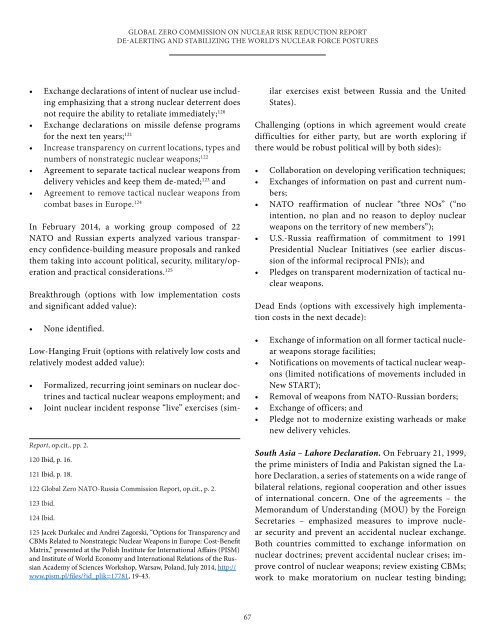global_zero_commission_on_nuclear_risk_reduction_report
global_zero_commission_on_nuclear_risk_reduction_report
global_zero_commission_on_nuclear_risk_reduction_report
Create successful ePaper yourself
Turn your PDF publications into a flip-book with our unique Google optimized e-Paper software.
GLOBAL ZERO COMMISSION ON NUCLEAR RISK REDUCTION REPORTDE-ALERTING AND STABILIZING THE WORLD’S NUCLEAR FORCE POSTURES• Exchange declarati<strong>on</strong>s of intent of <strong>nuclear</strong> use includingemphasizing that a str<strong>on</strong>g <strong>nuclear</strong> deterrent doesnot require the ability to retaliate immediately; 120• Exchange declarati<strong>on</strong>s <strong>on</strong> missile defense programsfor the next ten years; 121• Increase transparency <strong>on</strong> current locati<strong>on</strong>s, types andnumbers of n<strong>on</strong>strategic <strong>nuclear</strong> weap<strong>on</strong>s; 122• Agreement to separate tactical <strong>nuclear</strong> weap<strong>on</strong>s fromdelivery vehicles and keep them de-mated; 123 and• Agreement to remove tactical <strong>nuclear</strong> weap<strong>on</strong>s fromcombat bases in Europe. 124In February 2014, a working group composed of 22NATO and Russian experts analyzed various transparencyc<strong>on</strong>fidence-building measure proposals and rankedthem taking into account political, security, military/operati<strong>on</strong>and practical c<strong>on</strong>siderati<strong>on</strong>s. 125Breakthrough (opti<strong>on</strong>s with low implementati<strong>on</strong> costsand significant added value):• N<strong>on</strong>e identified.Low-Hanging Fruit (opti<strong>on</strong>s with relatively low costs andrelatively modest added value):• Formalized, recurring joint seminars <strong>on</strong> <strong>nuclear</strong> doctrinesand tactical <strong>nuclear</strong> weap<strong>on</strong>s employment; and• Joint <strong>nuclear</strong> incident resp<strong>on</strong>se “live” exercises (sim-Report, op.cit., pp. 2.120 Ibid, p. 16.121 Ibid, p. 18.122 Global Zero NATO-Russia Commissi<strong>on</strong> Report, op.cit., p. 2.123 Ibid.124 Ibid.125 Jacek Durkalec and Andrei Zagorski, “Opti<strong>on</strong>s for Transparency andCBMs Related to N<strong>on</strong>strategic Nuclear Weap<strong>on</strong>s in Europe: Cost-BenefitMatrix,” presented at the Polish Institute for Internati<strong>on</strong>al Affairs (PISM)and Institute of World Ec<strong>on</strong>omy and Internati<strong>on</strong>al Relati<strong>on</strong>s of the RussianAcademy of Sciences Workshop, Warsaw, Poland, July 2014, http://www.pism.pl/files/?id_plik=17781, 19-43.ilar exercises exist between Russia and the UnitedStates).Challenging (opti<strong>on</strong>s in which agreement would createdifficulties for either party, but are worth exploring ifthere would be robust political will by both sides):• Collaborati<strong>on</strong> <strong>on</strong> developing verificati<strong>on</strong> techniques;• Exchanges of informati<strong>on</strong> <strong>on</strong> past and current numbers;• NATO reaffirmati<strong>on</strong> of <strong>nuclear</strong> “three NOs” (“nointenti<strong>on</strong>, no plan and no reas<strong>on</strong> to deploy <strong>nuclear</strong>weap<strong>on</strong>s <strong>on</strong> the territory of new members”);• U.S.-Russia reaffirmati<strong>on</strong> of commitment to 1991Presidential Nuclear Initiatives (see earlier discussi<strong>on</strong>of the informal reciprocal PNIs); and• Pledges <strong>on</strong> transparent modernizati<strong>on</strong> of tactical <strong>nuclear</strong>weap<strong>on</strong>s.Dead Ends (opti<strong>on</strong>s with excessively high implementati<strong>on</strong>costs in the next decade):• Exchange of informati<strong>on</strong> <strong>on</strong> all former tactical <strong>nuclear</strong>weap<strong>on</strong>s storage facilities;• Notificati<strong>on</strong>s <strong>on</strong> movements of tactical <strong>nuclear</strong> weap<strong>on</strong>s(limited notificati<strong>on</strong>s of movements included inNew START);• Removal of weap<strong>on</strong>s from NATO-Russian borders;• Exchange of officers; and• Pledge not to modernize existing warheads or makenew delivery vehicles.South Asia – Lahore Declarati<strong>on</strong>. On February 21, 1999,the prime ministers of India and Pakistan signed the LahoreDeclarati<strong>on</strong>, a series of statements <strong>on</strong> a wide range ofbilateral relati<strong>on</strong>s, regi<strong>on</strong>al cooperati<strong>on</strong> and other issuesof internati<strong>on</strong>al c<strong>on</strong>cern. One of the agreements – theMemorandum of Understanding (MOU) by the ForeignSecretaries – emphasized measures to improve <strong>nuclear</strong>security and prevent an accidental <strong>nuclear</strong> exchange.Both countries committed to exchange informati<strong>on</strong> <strong>on</strong><strong>nuclear</strong> doctrines; prevent accidental <strong>nuclear</strong> crises; improvec<strong>on</strong>trol of <strong>nuclear</strong> weap<strong>on</strong>s; review existing CBMs;work to make moratorium <strong>on</strong> <strong>nuclear</strong> testing binding;67


